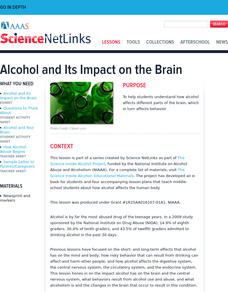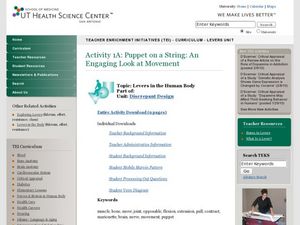Teach Engineering
Processes on Complex Networks
Introduces your class to random processes in networks with an activity that uses information about disease spread using the susceptible, infectious, resistant (SIR) model. Participants determine whether a susceptible person becomes...
LABScI
Vision Lab: The Eye
Our bodies have some amazing capabilities, but there are some limitations. Explore the limitations of the human eye through the eighth lab activity in a series of 12 biology lessons. Individuals measure their own peripheral vision...
Curated OER
Alcohol and Its Impact on the Brain
Students examine water as it changes states. In water and ice lesson students study the water cycle and what happens to it as it changes state.
Curated OER
Drawing Lessons
Middle schoolers recognize and respond to the content of visual art using art vocabulary. They recognize the differences between art materials, techniques, and processes.
Teach Engineering
Complex Networks and Graphs
Show your class how engineers use graphs to understand large and complex systems. The resource provides the beginnings of graph theory by introducing the class to set theory, graphs, and degree distributions of a graph.
Curated OER
Pea Brain! Explorations in Estimation
Students estimate how many peas fit in a container. In this science lesson plan, students calculate the weight of a pea and record it. They use this data to calculate how many peas fit in a human brain.
Curated OER
Ten Questions About The Human Body
In this human body learning exercise, students complete a set of 10 questions, answering in space provided. Worksheet has a link to additional activities.
Curated OER
How Alzheimer's Affects the Brain
Young scholars study how Alzheimer's affects different parts of the brain, sketch a healthy neuron and its parts, and diagram brain changes during the early and late stages of Alzheimer's.
Curated OER
Tales From The Tummy
Students use creative writing in order to review the digestive system and other various parts of the human body. They write a creative story about a hamburger and the journey it takes during digestion. The lesson includes key words that...
Curated OER
Puppet on a String: An Engaging Look at Movement
Learners examine how muscles can work together with joints. In this movement activity students use a marionette to observe how muscles work.
Curated OER
Facebook and Social Networking
Students explore Internet communication by researching Facebook. In this social networking lesson, students discuss the uses for Facebook, their own experience with the program, and the dangers of using on-line communication tools....
Curated OER
The Human Organism
Eighth graders investigate animal behavior by studying the lives of three female behavior scientists. For this human organism lesson students do different activities that inquire and approach each females work.
Curated OER
Technology and the Human Eye
Fifth graders compare technology and the human eye. In this science instructional activity, 5th graders label the parts of the human eye and trace the path of light as it travels through the eye.
Curated OER
Brain and Nervous System
Third graders study the physical characteristics of the brain and identify its parts through this series of lessons.
Curated OER
Exploring Learned and Innate Behavior
Students explore the differences between learned and innate behavior among humans and monkeys. They complete an assignment and read articles about two studies, which used similar test methods to show that infants and monkeys share an...
University of Minnesota
Connect the Neurons!
Create a neuron frenzy as your pupils play the part of the neurons. An engaging lesson creates a human chain of neurons that pass cotton balls posing as neurotransmitters. Scholars learn about pre- and post-synapses as they complete...
Curated OER
Food for Thought
Fifth graders explore the brain and what is needs. In this biology lesson plan, 5th graders will work on a series of activities that will allow them to learn about the brain, its parts, and the best foods to eat for their brain.
Curated OER
Applied Science - Science and Math Lab
Students explore the senses. In this Applied Science instructional activity, students investigate the items in "feely" boxes with their hands, both touching the items and shaking the boxes to hear the sound the items make. Students also...
Curated OER
The Science of Addition
Students examine the science of drug addition. In this health related lesson, students take a pre-assessment about drug addiction, then read and discuss an article about how some drugs affect the brain to cause addition. They will...
Curated OER
An Eye on Science
Young scholars investigate the human eye and its parts. They read and discuss various books about eyes and sight, draw a rough draft of an eye diagram, and create a final draft of their eye diagram including labeled parts using Kid Pix...
Curated OER
How to Make an Artificial Organ
Students design bionic organs or limbs. In this medical technology lesson, students view a video about artificial organs and prosthetic limbs. They research the medical technology behind these advances and work to design a organ or limb...
Curated OER
Human Evolution
High schoolers investigate hominid evolution to learn the difference between a relative and an ancestor. They study the emergence of bipedalism and the related physical adaptations and cultural ramifications, and chart patterns of...
Curated OER
Exploring the Nervous System Through Disease and Injury
Students are introduced to the nervous system. In groups, they research the relationship between disease and injury and how it affects the nervous system. To end the lesson, they present their findings to the class and create a poster.
Curated OER
Body Systems
In this body systems lesson, students work in small groups conduct research to become an 'expert' on one of the 7 body systems. Students present their findings to the class via power point, poster, or song.

























